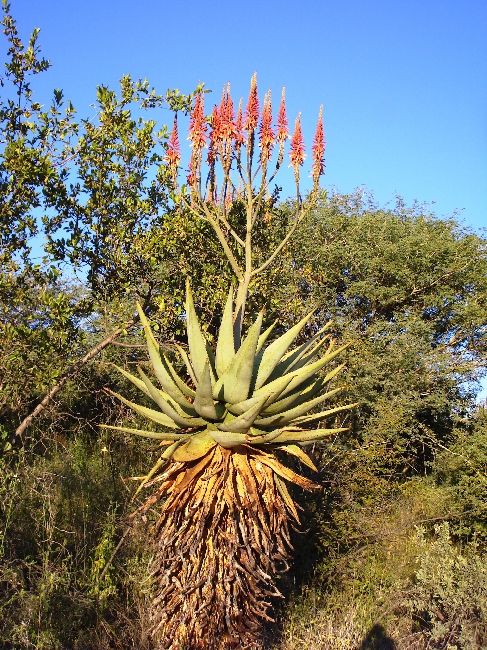LUISE HOFFMANNTOPPED by its characteristic rosette of grey green leaves, its straight unbranched trunk covered in a shaggy cloak of shrivelled old leaves, this aloe is easy to spot.
The leaves are armed with brown teeth along the margins and young leaves often have white speckles. A many branched, erect spray of red tubular flowers grows out of the centre of the leaf rosette.
The flowers are pale red to deep red, the tips turning yellow over time, and are often covered in a waxy layer giving them a silvery sheen. The fruit is a capsule containing many small, black, winged seeds.
Names: A. Windhoekaalwyn, berg shy;aalwyn; G. Bergaloe; H. Otjindombo. N. augoreb; Nd. Endombo. Llittoralis means ‘growing along the beach/river banks’. This does not apply to Namibia but the first specimen was collected by the botanist Welwitsch on hill slopes facing the ocean north of Luanda in Angola and was thus named accordingly.
As the emblem of the city of Windhoek, the mountain aloe appears on all municipal vehicles and on the city’s stationery, hence the common name.
This aloe is often found on hill slopes, usually on stony ground, either singly or in smaller or larger groups e.g. along the B1 about halfway between Otjiwarongo and Otavi or along the C22 to the Waterberg.
Most of these aloes along the hill separating Windhoek from Klein Windhoek and in the National Botanic Garden died after the particularly heavy rainy season 2010/2011 when the capital received more than three times the average rainfall.
They succumbed to fungal rot due to the damp conditions. In addition, the snout beetle did considerable damage by laying eggs in the crown of the plants. The larvae feeding on the young emerging leaves damage the growth point and often cause it to rot and die. Fortunately young aloes are sprouting again.
The plant is easily destroyed by fire. In dry years baboons climbing the plants to reach the flowers, which contain copious amounts of nectar, often break them down. They are also harmed by rock hyraxes eating the succulent leaves.
The nectar contains several minerals and vitamins. The flowers may be eaten directly off the plant or boiled and eaten or pounded into a soft, sticky mass, shaped into patties and dried for later use. Various sunbirds, grey louries and other birds, moths, flies and other insects are attracted by the nectar.
The plant is frequently affected by white scale and visited by spiders, plant lice, various ant species, weevils and parasitic wasps. The aloe is a well known folk remedy. The juice from the leaves is used to treat eye problems. A daily dose of a watery decoction of the leaves allegedly prevents malaria and alleviates venereal disease. The powdered dry leaves heal wounds.
Farmers used to place cut up aloe leaves in water troughs to protect their animals against ticks and lice. Boiling the cut up leaves in water and straining the gelatinous juice provides an effective purgative for man and beast.
Plants are available from the nurseries of the Forestry Directorate. They grow well, especially on alkaline soils.
They can also readily be raised from seed. During the first years they should be protected from frost and they should be watered sparingly.
In Namibia, all succulents are protected plants.
Stay informed with The Namibian – your source for credible journalism. Get in-depth reporting and opinions for
only N$85 a month. Invest in journalism, invest in democracy –
Subscribe Now!






